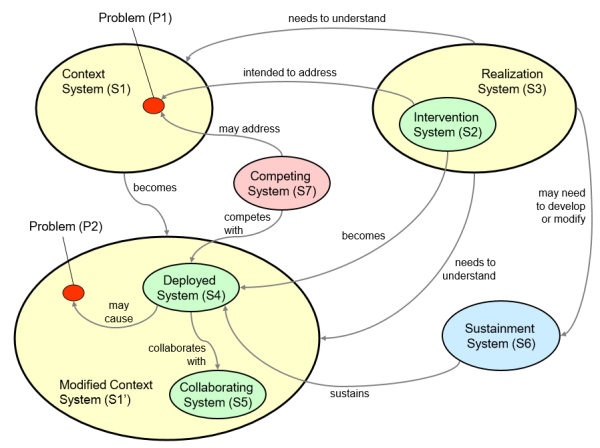User Tools
Table of Contents
Introduction to Systems Engineering
Definition
What it is
What it is not
Rationale
Pre-condition
Post-condition
Performance Qualities
Leading source for the performance qualities of the Systems Engineering activities is G. Roedler, D.H. Rhodes, H. Schimmoller & C. Jones, “Systems Engineering Leading Indicators Guide” LAI, INCOSE, PSM and SEAri, INCOSE Technical Product Number: INCOSE-TP-2005-001-03 Version 2.0 (2010). Accessed on September 10th, 2020 here.
Problem
Methodology
Method
As with any method there needs to be a clear set of requirements that it needs to address. Below requirements are borrowed from D. Long & Z, Scott “A Primer for Model-Based System Engineering”, Vitech Corporation, 2nd edition (2011). I've only replaced 'process' with 'methodology' to broaden the scope as well as replaced 'must' with 'shall' to make it consistent with standard requirements terminology. Requirement 5, regarding tailoring, is my own addition.
- Requirement 1: The methodology shall consistently lead to the development of successful systems
- Requirement 2: The methodology shall manage system complexity well
- Requirement 3: The methodology shall lead to effective solutions to a broad range of customer needs
- The methodology shall not be too narrow to deal with any particular domain/sub-domain
- Requirement 4: The methodology shall accommodate three main problem classes (engineering unprecedented systems, reverse engineering, and engineering precedented systems)
- Requirement 5: The methodology shall allow for tailoring to adapt to particular risk profile and project constraints
J. Martin proposed in Martin, J. 2004. “The Seven Samurai of Systems Engineering: Dealing with the Complexity of 7 Interrelated Systems.” Proceedings of the International Council on Systems Engineering (INCOSE) International Symposium, 2004, Toulouse, France that there exists seven systems in the design space.
Above figure is from a presentation given by J. Martin in 2012.
These are:
- Context System
- Intervening System (“as-designed” system)
- Realization System (e.g. design teams, production systems)
- Deployed System (“as-built” system)
- Collaborating System (e.g. external systems)
- Sustainment System (e.g. maintenance)
- Competing System
Interactions between the systems are
- Context System contains Problem
- Intervening System is intended to address Problem
- Realization System brings Intervening System into being
- Intervening System is a part of Realization System
- Realization System needs to understand Context System
- Realization System needs to understand the Modified Context System
- Realization System may need to develop or modify the Sustainment System
- Intervening System becomes Deployed System
- Context System becomes the Modified Context System
- Deployed System is contained in Modified Context System
- Deployed System interacts with one or more Collaborating Systems
- Deployed System is sustained by Sustainment System
- Deployed System may cause new Problem
- Competing System(s) may address the original Problem
- Competing System(s) compete with Deployed System for resources and for the attention of users and operators
Heuristics
Process
Systems Engineering for Intervention System
There exists many processes which appear as linear and sequential when in fact many steps occur in parallel an recursively. One of which is SIMILAR
SIMILAR
- State the Problem
- Investigate Alternatives
- Model the System
- Integrate
- Launch the System
- Assess Performance
- Re-evaluate


